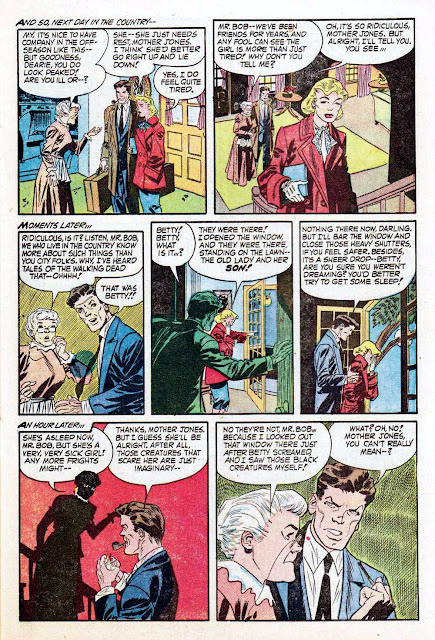An clever attempt at getting as close to the word "Terror" without raising the ire of the newly-adopted Comics Code Authority, TERRIFIC was the last of Comic Media's horror comics (WEIRD TERROR #13 preceded it in September).
Comic Media was formed in 1952 under the company, Allen Hardy Associates after Hardy left Harvey Comics. He took with him one of the premiere horror comic artists at the time, Don Heck, who was adept at creating particularly revolting covers along with his interior art. Also jumping ship from Harvey was Pete Morisi (aka PAM). Other imprints under the company were Artful Publications Inc. and Harwell Publications Inc.
During its short, two-year existence, Comic Media published Western, romance, adventure, humor, and war titles along with horror. Created by Pete Morisi, Johnny Dynamite was the most popular character to come out of the line.
Hardy had a call for submissions that appeared in the August 1953 issue of WRITER'S DIGEST, which was known for regularly providing market reports for various comic book publishers. He stated he wanted "the unusual, artists and writers who don't have hackneyed approach to comics[sic]."
 |
| Writer's Digest, August 1953 |
Comic Media ceased publishing in 1954. Most of the titles were sold to Charlton. Farrell continued TERRIFIC for one more issue (a non-horror comic featuring Wonder Boy) in March 1955, then disappeared. Don Heck went on to work for Atlas, which soon became Marvel. Pete Morisi had a successful career with Charlton.
Don Heck later commented on Hardy's death: "Allen was an alcoholic. He was a member of AA but he went off the wagon. While he was in this way, I could not leave him." He added, "I stayed until I cleaned up the stuff for Allen Hardy who, by that time, couldn't do anything. He had to go back for treatment. Not too long after that he died. I heard the story he was smoking a cigarette and it dropped and he burned himself to death. I liked him! He was a good guy as far as I was concerned."
TERRIFIC
Vol. 1 No. 14 (first/last issue)
December 1954
Mystery Publishing Company Inc. (Comic Media)
Editor: Alan Hardy
Cover: Don Heck
Pages: 36
Cover price: 10 cents
CONTENTS
"Dead on Arrival"
Script: ?
Art: Marty Elkin
"Human Cross"
Script: ?
Art: Don Heck
"The Wolf Twins"
Script: ?
Pencils: Ross Andru?
Inks: Steve Kirkel
"Dance of Death"
Script: ?
Art: Rudy Palais
.jpg)


























































